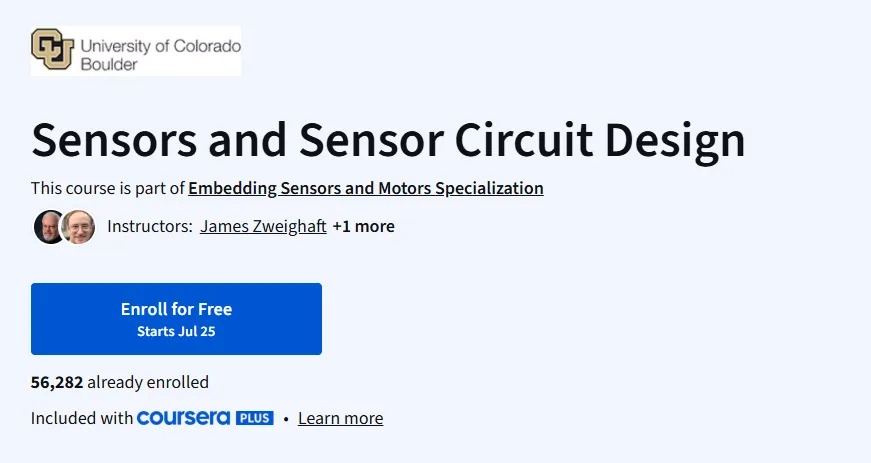Sensors and Sensor Circuit Design
A hands-on, simulation-rich course that teaches you how to design and analyze real-world sensor circuits.
What will you learn in Sensors and Sensor Circuit Design Course
Understand how sensors work and how they interact with electronic circuits.
Learn to design and simulate sensor circuits using LTspice.
Interpret and manipulate voltage/current signals from different types of sensors.
Develop practical skills in analog and digital sensor integration.
Program Overview
Module 1: What Are Sensors?
⏱️ 1 week
Topics: Basic sensor principles, classification (active/passive), analog vs digital signals.
Hands-on: Signal interpretation exercises using basic sensor types.
Module 2: Voltage Divider Circuits & Simulations
⏱️ 1 week
Topics: Ohm’s Law, voltage division, simulating resistive sensors (e.g., thermistors, LDRs).
Hands-on: LTspice-based simulation of resistive sensor circuits.
Module 3: Current-Based Sensor Circuits
⏱️ 1 week
Topics: Hall effect sensors, photodiodes, op-amp current sensing circuits.
Hands-on: Lab-style simulations and current-sensing applications.
Module 4: Digital Sensor Output Circuits
⏱️ 1 week
Topics: Interfacing digital sensors, pull-up resistors, Schmitt triggers, logic-level interfacing.
Hands-on: Design circuits with digital sensor outputs and simulate threshold behavior.
Module 5: Capstone Project
⏱️ 1 week
Topics: Combine multiple sensors in a simulation environment, troubleshoot signal pathways.
Hands-on: Complete design and simulation of a multi-sensor application using LTspice.
Get certificate
Job Outlook
High Demand: Core skill for electronics, IoT, robotics, and automation industries.
Industries: Automotive, healthcare, consumer electronics, manufacturing.
Roles: Embedded Systems Engineer, Circuit Designer, IoT Developer, Hardware Engineer.
Salary Range: $60,000–$120,000 depending on region and experience.
Skills Gained: Analog circuit design, sensor interfacing, LTspice simulation.
- Strong focus on LTspice simulations
- Simple yet effective analog circuit designs
- Beginner-friendly pacing
- Requires some familiarity with basic electronics
- Limited real hardware interaction (simulation-based)
Specification: Sensors and Sensor Circuit Design
|
FAQs
- Basic understanding of electricity and circuits is helpful but not mandatory.
- The course introduces sensor concepts and circuit design step-by-step.
- Learners gradually understand different types of sensors and their applications.
- Hands-on examples connect theory to practical circuit implementation.
- Beginners can develop foundational skills in designing and using sensor circuits.
- The course covers designing circuits for temperature, motion, light, and other sensors.
- Learners practice integrating sensors with microcontrollers and other components.
- Real-world examples demonstrate practical circuit layouts and troubleshooting.
- Step-by-step guidance ensures proper design and implementation techniques.
- Hands-on projects help learners build a portfolio of sensor-based circuits.
- Learners explore applications in automation, robotics, and IoT systems.
- Exercises demonstrate sensor selection and optimization for different use cases.
- Knowledge of signal processing and interfacing techniques is provided.
- Practical guidance helps learners design circuits for accurate and reliable sensing.
- Skills gained are directly applicable to engineering, electronics, and embedded system projects.
- Sensor and circuit design skills are in demand in electronics, robotics, and IoT industries.
- Knowledge improves employability for roles such as electronics engineer, embedded systems engineer, or IoT developer.
- Hands-on projects demonstrate practical ability to potential employers.
- Understanding sensor integration enhances professional credibility and technical expertise.
- Completion shows readiness to contribute to sensor-based product design and engineering projects.
- Estimated completion is around 4–6 weeks at a part-time pace.
- Weekly effort of 4–6 hours is generally sufficient for lectures and hands-on exercises.
- Regular practice in designing, testing, and debugging circuits reinforces learning.
- Revisiting exercises or experimenting with additional sensor applications may require extra time.
- Consistent engagement ensures learners develop both conceptual understanding and practical sensor circuit design skills.





